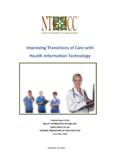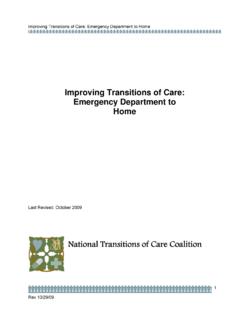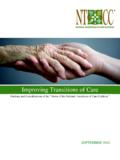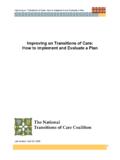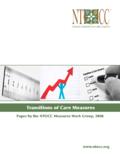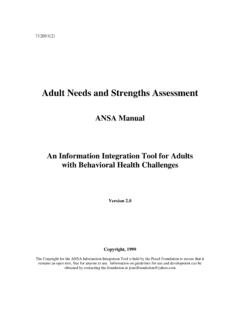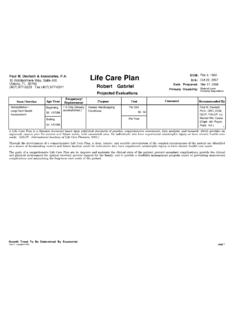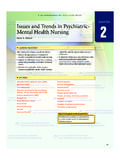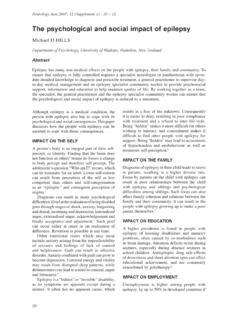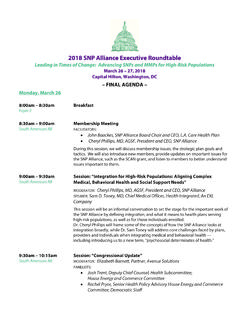Transcription of APPENDIX C Elements of Excellence in Transitions of Care ...
1 1 APPENDIX C Elements of Excellence in Transitions of Care (TOC) TOC Checklist *The purpose of this checklist is to enhance communication among health care providers, between care settings, and between clinicians and clients/caregivers of patient assessments, care plans, and other essential clinical information. The checklist can serve as an adjunct to each provider s assessment tool, reinforcing the need to communicate patient care information during Transitions of care. This list may also identify areas that providers do not currently assess but may wish to incorporate in the patient s record.
2 Every element on this checklist may not be relevant to each provider or setting. *For purposes of brevity, the term patient/client is used throughout this checklist to describe the client and client system (or patient and family). The patient/client system (or family), as defined by each patient/client, may include biological relatives, spouses or partners, friends, neighbors, colleagues, and other members of the patient/client s informal support network. Depending on the setting in which this checklist is used, providers may wish to substitute resident, consumer, beneficiary, individual, or other terms for patient/client.
3 Overarching Concepts Engagement Maximize patient/client involvement in all phases of intervention by promoting self-determination and informed decision-making. Provide educational information to support the patient/client s participation in the plan of care. Protect patient/client s right to privacy and safeguard confidentiality when releasing patient/client information. Affirm patient/client dignity and respect cultural, religious, socioeconomic, and sexual diversity. Assess and promote the patient/client s efforts to participate in the plan of care. 2 Collaboration Define multidisciplinary team participants.
4 Build relationships with all team members, with the patient/client at the center of the collaborative model. Communicate with other professionals and organizations, delineating respective responsibilities. Create awareness of patient/client and provider accountability for receiving and sending patient/client care information to and from care settings. Provide services within the bounds of professional competency and refer patient/client as needed. Strengths-based assessment Use respect and empathy in patient/client interactions. Recognize patient/client s strengths and use those abilities to effect change.
5 Help patient/client use effective coping skills and insights to manage current crises. Recognize and help resolve patient/client s difficulties. Distinguish cultural norms and behaviors from challenging behaviors. Assessment as an ongoing process Keep assessments flexible, varying with presenting problem or opportunity. Regularly reassess patient/client s needs and progress in meeting objectives. Facilitate goal-setting discussion based upon the patient/client s needs during all phases of care. Assess effectiveness of interventions in achieving patient/client s goals.
6 Communicate changes in assessment and care plan to the health care team. Common Elements for Assessment and Intervention Physiological functioning Assess patient/client s understanding of diagnosis, treatment options, and prognosis. Evaluate patient/client s life care planning and advance directive status. Evaluate impact of illness, injury, or treatments on physical, psychosocial , and sexual functioning. Evaluate patient/client s ability to return to or exceed pre-illness or pre-injury function level. psychosocial functioning Assess past and current mental health, emotional, cognitive, social, behavioral, or substance use/abuse concerns that may affect adjustment to illness and care management needs.
7 Assess effect of medical illness or injury on psychological, emotional, cognitive, behavioral, and social functioning. 3 Determine with patient/client which psychosocial services are needed to maximize coping. Cultural factors Affirm patient/client dignity and respect cultural, religious, socioeconomic, and sexual diversity. Assess cultural values and beliefs, including perceptions of illness, disability, and death. Use the patient/client s values and beliefs to strengthen the support system. Understand traditions and values of patient/client groups as they relate to health care and decision-making.
8 Health literacy and linguistic factors Provide information and services in patient/client s preferred language, using translation services and interpreters. Use effective tools to measure patient/client s health literacy. Provide easy-to-understand, clinically appropriate material in layperson s language. Use graphic representations for patients/clients with limited language proficiency or literacy. Check to ensure accurate communication using teach-back methods. Develop educational plan based upon patient/client s identified needs. Evaluate caregiver s capacity to understand and apply health care information in assisting patient/client.
9 Financial factors Identify patient/client s access to, type of, and ability to navigate health insurance. Identify patient/client s access to and ability to navigate prescription benefits. Evaluate impact of illness on financial resources and ability to earn a living wage. Provide feedback on financial impact of treatment options. Educate patient/client about benefit options and how to access available resources. Assess barriers to accessing care and identify solutions to ensure access. Spiritual and religious functioning Assess how patient/client finds meaning in life.
10 Assess how spirituality and religion affect adaptation to illness. Physical and environmental safety Evaluate patient/client s ability to perform activities of daily living and meet basic needs. Assess environmental barriers that may compromise the patient/client s ability to meet established treatment goals. Determine with patient/client the appropriate level of care. Assess ability of family or other informal caregivers to assist patient/client. 4 Assess for risk of harm to self or others. Family and community support Identify patient/client s formal and informal support systems.

